
The black toad, also known as the Inyo toad or Deep Springs toad, is a true toad that lives only in scattered oases in the Deep Springs Valley of Inyo County, California. In fact, its original scientific name, Bufo exsul, means "exiled toad," which refers to its species' isolation in a tiny spot in the high desert wilderness of the Californian Great Basin.
Peltophryne fluviatica, also known as the Dominican Caribbean toad or Hispaniolan crestless toad, is a species of toad endemic to the Cibao Valley in the northwestern Dominican Republic. It has only been recorded at two localities.
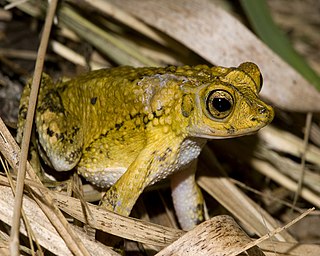
The Puerto Rican crested toad, or simply Puerto Rican toad, is a species of toad found only in Puerto Rico and the Virgin Islands. It is the only species of toad native to Puerto Rico and the Virgin Islands. The species formerly occurred in Virgin Gorda and along the southern and northern karst in Puerto Rico. It is listed as a threatened by the US Fish and Wildlife Service due to habitat loss and introduced species. At one period of time it was believed to be extinct until it was rediscovered in 1966. The IUCN has the species listed as endangered.
Bombina microdeladigitora is a species of toad in the family Bombinatoridae endemic to Guangxi, Hubei and Sichuan in China. It is commonly known by several names including Guangxi firebelly toad, Hubei firebelly toad, large-spined bell toad, Lichuan bell toad, small-webbed bell toad, and Yunnan firebelly toad. Its natural habitats are subtropical or tropical moist montane forests, temperate forests, rivers, swamps, and freshwater marshes. It is threatened by habitat loss.
Rhinella amboroensis is a species of toad in the family Bufonidae that is endemic to the region of its type locality in the Carrasco Province of Bolivia and the adjacent Santa Cruz Department. Its common name is Cochabamba toad. It may exist in the Carrasco National Park and/or Amboró National Park, depending on its exact range.
The Cuban pine toad, or Schwartz's Caribbean toad, is a species of toad in the family Bufonidae.
Nannophryne cophotis, or the Paramo toad, is a species of toad in the family Bufonidae that is endemic to northern Peru. Its natural habitats are puna grassland, high-altitude plateaus, and dry scrubland; it also occurs agricultural land. It breeds in temporary small ponds and permanent shallow streams at altitudes of 2000-4100 meters asl. Individuals have not been recorded since 2005, after what was believed to be a severe decline in its population. It was last known from: Granja Porcón & El Empalme (1999-2000); La Libertad (2003); Ancash (2004); and Cajamarca (2005). If a population exists it is believed to have 0-49 individuals remaining threatened from loss of habitat, pollution, conversion of land for farming, small and large-scale mining concessions, and the modification of waterways.
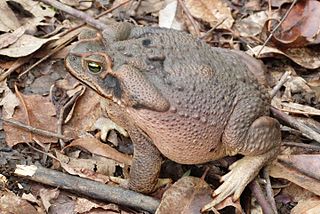
Rhinella diptycha, sometimes referred to as Cope's toad, Sneed toad, Schneider's toad, cururu toad, or rococo toad, is a toad found in northern Argentina, Paraguay, Uruguay, eastern Bolivia, and eastern and southern Brazil. It is one of three rather similar species sometimes referred to as "cururu toads" in Brazil, the others being R. jimi and R. marina. Like those, R. diptycha is a large toad, females up to 25 cm (9.8 in) in snout–to–vent length and males up to 18 cm (7.1 in).
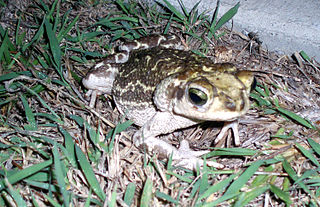
The Cuban small-eared toad, also known as the Cuban toad or Cope's Caribbean toad, is a species of toad in the family Bufonidae that is endemic to Cuba including Isla de Juventud.

The western giant toad is a species of toad in the family Bufonidae that is endemic to western Cuba. It occurs in a range of habitats including broadleaf forest, grassland, savanna, and agricultural areas. It is a common species but it can be locally threatened by habitat loss.
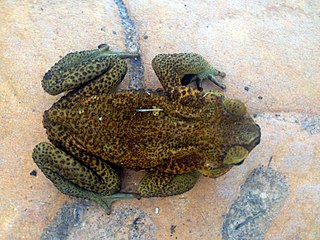
Peltophryne guentheri, the southern crested toad or Gunther's Caribbean toad, is a species of toad in the family Bufonidae. It is endemic to Hispaniola and found in the lowlands of Haiti and the Dominican Republic.
The Cuban high-crested toad, or Gundlach's Caribbean toad, is a species of toad in the family Bufonidae that is endemic to Cuba.
The Cuban long-nosed toad, or Stejneger's Caribbean toad, is a species of toad in the family Bufonidae. It is endemic to Cuba and only known from three widely separated populations. Its natural habitats are upland pinewoods and mesic broadleaf forests. It is always found by streams. It is threatened by habitat loss caused by logging, charcoaling, fires, and agricultural expansion.
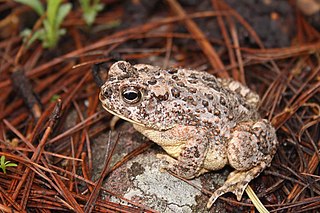
The southwestern toad or Mexican Madre toad, formerly Bufo mexicanus, is a species of toad in the family Bufonidae. It is endemic to north-western Mexico and found on the Sierra Madre Occidental in eastern Sonora and western Chihuahua and south to south-western Durango. Its natural habitats are conifer forests, commonly along low rivers and streams, its breeding habitat. It is a rare species threatened by habitat disturbance, including alterations causing the desiccation of streams and soils.

The western leopard toad is a species of toad in the family Bufonidae. The species is endemic to the low-lying areas of the Cape Peninsula, the Cape Flats and the Agulhas flats of the Western Cape, South Africa.

Peltophryne peltocephala is a species of toad in the family Bufonidae. It is endemic to Cuba and found in central and eastern Cuba as well as on some outlying islands. It occurs in a range of habitats including broadleaf forest, grassland, savanna, and agricultural areas. It is a common species but locally threatened by habitat loss.
Leptobrachium ailaonicum is a species of amphibian in the family Megophryidae. It is found in Yunnan in southern China and on Fansipan mountain in northern Vietnam. Its type locality is Xujiaba in the Ailao Mountains in Jingdong County, Yunnan. At the time of the IUCN assessment in 2004, the population on Fansipan was considered a separate species, Leptobrachium (Vibrissaphora) echinatum, and assessed to be an endangered species.

Rhinella achavali is a species of toads in the family Bufonidae that is found in Uruguay and southernmost Brazil.

Peltophryne is a genus of true toads in the family Bufonidae, from the Greater Antilles. With ten endemic species, Cuba hosts the highest diversity. Hispaniola has three endemics and Puerto Rico and the Virgin Islands combined have one.











